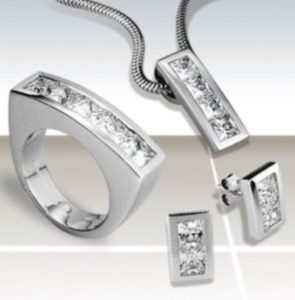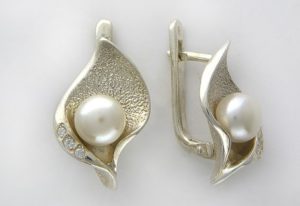Silver is one of the most noble and aesthetically pleasing metals. It is used to make jewelry, some household items and interior decoration. Many people notice that over time, their favorite silver earrings lose their former shine, turn black, and become dull. Fortunately, there are a variety of ways to clean silver items, most of which will be discussed in this article.
Rules for cleaning silver earrings
The method for purifying silver depends on many factors. Pay attention to:
 composition of the jewelry (look at the sample: are there any alloys of another metal in the earrings?);
composition of the jewelry (look at the sample: are there any alloys of another metal in the earrings?);- size;
- the presence of additional elements: precious stones, enamel, gilded plating, etc.;
- degree of contamination and plaque.
Remember an important rule: For jewelry with expensive stones or other inserts, always use only gentle cleaning methods! In this case, it is better to simply wipe the earrings with a special cloth or give them to a professional jeweler.The same applies to carved, filigree jewelry. In other cases, you can cope on your own.
Ways to clean silver
Next, we will look at several ways in which you can clean silver earrings at home.
Ammonia
Ammonia is an aggressive agent, so this method is suitable for simple products without precious stones. If there is slight darkening, it is enough to moisten a cotton pad in ammonia and wipe the earrings. If the contamination is strong enough, you can dip the silver in ammonia for a couple of minutes (if you are afraid, dilute it with a little water).
Important! After each method, you need to rinse the earrings in cool running water, wipe dry and polish with a soft cloth.
Hydrogen peroxide
You can clean silver using hydrogen peroxide, but you must also proceed with great care. More often A 3% peroxide solution is diluted with water and liquid soap.. You can also mix a mixture of peroxide and soda and wipe the jewelry with a soft cloth.
Toothpaste
 Brushing with toothpaste is quite effective, but should be done with caution. The paste usually contains a fine abrasive that can damage the thin coating. Choose a toothpaste without large particles and use a soft cloth rather than a rough toothbrush.. Apply it to the earrings and wipe them with gentle movements. Do not press to avoid damaging the surface. After this, rinse off the paste under running water and polish the jewelry.
Brushing with toothpaste is quite effective, but should be done with caution. The paste usually contains a fine abrasive that can damage the thin coating. Choose a toothpaste without large particles and use a soft cloth rather than a rough toothbrush.. Apply it to the earrings and wipe them with gentle movements. Do not press to avoid damaging the surface. After this, rinse off the paste under running water and polish the jewelry.
Soda
For minor stains, a mixture of baking soda and water is perfect. Mix the paste and apply to the jewelry for 5-10 minutes. For effectiveness, you can add a couple of drops of hydrogen peroxide to the mixture.
Citric acid, vinegar
Heat table vinegar or citric acid diluted with water in a ratio of 1:5 to 40–50 °C. Immerse the silver in the solution for 10–15 minutes. If it is not very blackened, you can wipe it with a cloth soaked in a warm solution. Don't forget to wash your jewelry.
Important! Solutions containing acids cannot be used on earrings with stone or enamel inserts.
Alcohol
 Small stains can be easily removed with ordinary alcohol. Dampen a cotton swab and gently remove any dirt. You can use a cotton swab for hard-to-reach places.
Small stains can be easily removed with ordinary alcohol. Dampen a cotton swab and gently remove any dirt. You can use a cotton swab for hard-to-reach places.
Coca Cola
Any carbonated drinks such as Coca-Cola, Mirinda or Sprite contain phosphoric acid, which removes the blackness from silver. The earrings are placed in the drink and boiled over low heat for 5–7 minutes.
Potatoes
Our grandmothers bleached silver using potato broth. It was cooled a little, and then the earrings were placed there. Everything took about 5 minutes.
Ashes
In ancient times, silver was cleaned using ash or ashes. To do this, they carefully rubbed the surface with it, and then washed the earrings in clean water, dried and polished.
Lactic acid products
If you put silver in kefir or other fermented milk product, then in 20–30 minutes the excess plaque will disappear. Don't forget to rinse the product thoroughly and polish it.

Copper and foil
Our grandmothers also believed that silver is cleaned much better next to aluminum or copper objects. To do this, you can add a little foil to a boiled solution of water and soda, dip the earrings in it and hold for about 15 minutes.
Subtleties of cleaning items with stones and blackened silver
 Accessories with stones should be cleaned in the most gentle manner.. Do not use abrasives: they will scratch the stone and make it dull. Give preference to alcohol or soap solution: they have the least impact on the gemstone.
Accessories with stones should be cleaned in the most gentle manner.. Do not use abrasives: they will scratch the stone and make it dull. Give preference to alcohol or soap solution: they have the least impact on the gemstone.
Blackened silver is a special type of metal. Blackening is created by jewelers through chemical or mechanical reactions. The advantage of such products is they are very easy to clean, so there is no need and cannot use abrasives or boiling. Simply wipe the surface with a soft cloth or dip it in a cool soapy solution.
Ultrasonic cleaning - when is it necessary?
 In a jewelry workshop, you can clean silver earrings using ultrasonic waves. Masters use special ultrasonic baths - vessels filled with liquid. After turning on the ultrasound, vibrations are formed in the vessel, due to which the metal is quickly cleaned.
In a jewelry workshop, you can clean silver earrings using ultrasonic waves. Masters use special ultrasonic baths - vessels filled with liquid. After turning on the ultrasound, vibrations are formed in the vessel, due to which the metal is quickly cleaned.
This the method is the most effective of all those that can be done independently at home. Thanks to vibrations, plaque and dirt are removed from the most inaccessible and prominent places of the earrings. That's why in particularly advanced cases, when the earrings are completely covered with black plaque, only ultrasonic cleaning can save the situation.
Important! Ultrasonic cleaning cannot be performed if the jewelry contains inserts of certain precious stones. Before carrying out the procedure, consultation with a competent jeweler is required to eliminate the risk of damage to an expensive accessory. Ultrasound can cause some stones to lose their shine.
Why do earrings get dirty?
In ancient times, it was believed that the blackening of silver jewelry meant bringing damage or the evil eye to a person. In the modern world, magical rituals are a thing of the past, and scientists have discovered a completely logical reason for the darkening of silver. It's all about oxidation. Under certain conditions, a chemical reaction occurs on the surface of the product and the silver darkens. Among the reasons are the following:
 contact with the human body. Constant contact with skin causes oxidation of the metal. There can be many reasons for this: sweating, breathing, wet skin, sebum secretion, etc.;
contact with the human body. Constant contact with skin causes oxidation of the metal. There can be many reasons for this: sweating, breathing, wet skin, sebum secretion, etc.;- storage in conditions of high humidity;
- contact with certain cosmetic products and other household chemicals;
- low metal standard.
Many have noticed that silver items darken even when they are kept in a dark bag and not worn for a long time. Even in such conditions, they are exposed to humid air, so from time to time we advise you to clean all the jewelry in your collection.


 composition of the jewelry (look at the sample: are there any alloys of another metal in the earrings?);
composition of the jewelry (look at the sample: are there any alloys of another metal in the earrings?); contact with the human body. Constant contact with skin causes oxidation of the metal. There can be many reasons for this: sweating, breathing, wet skin, sebum secretion, etc.;
contact with the human body. Constant contact with skin causes oxidation of the metal. There can be many reasons for this: sweating, breathing, wet skin, sebum secretion, etc.; 0
0





